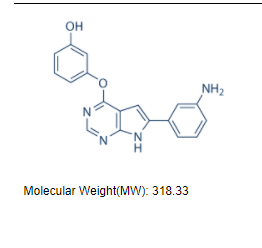| 1.Inquiries will be replied within 24 hours |
| 2.We could supply various packages as you required |
| 3.To protect the profit of our agents, price will not show on website, please send inquiries to get the price. |
| 4.Fast delivery, goods arrive your office within 3 to 5 days |
| 5.Please click "Inquiry" or "Email" below to get the price |
|
|
|
|
|
|
|
C18H14N4O2 |
|
|
|
|
C18H14N4O2 |
|
in stock |
|
|
601514-19-6 |
|
98%+ |
Introduction
Treatment of a monolayer of P19 cells with 1 μM TWS119 causes 30–40% cells to differentiate specifically into neuronal lineages based on counting of TuJ1 positive cells with correct neuronal morphology (up to 60% neuronal differentiation occurred through the standard EB formation protocol with concomitant TWS119 treatment). TWS119 tightly binds to GSK-3β (K D = 126 nM) which is quantified by surface plasmon resonance (SPR) and further demonstrates an IC50 of 30 nM. TWS119 is found to potently induces neuronal differentiation in both mouse embryonal carcinoma and ES cells. TWS119 treatment towards hepatic stellate cells (HSC) leads to reduced b-catenin phosphorylation, induces nuclear translocation of b-catenin, elevates glutamine synthetase production, impedes synthesis of smooth muscle actin and Wnt5a, but promotes the expression of glial fibrillary acidic protein, Wnt10b, and paired-like homeodomain transcription factor 2c. TWS119 triggers a rapid accumulation of β-catenin (mean 6.8 -fold increase by densitometry), augments nuclear protein interaction with oligonucleotide containing the DNA sequences to which Tcf and Lef bind and sharply up-regulates the expression of Tcf7, Lef1 and other Wnt target genes including Jun, Ezd7 (encoding Frizzled-7), Nlk (encoding Nemo-like kinase). TWS119 induces a dose-dependent decrease in T cell-specific killing and IFN-g release associated with the preservation of the ability to produce IL-2. A recent study indicates Wnt signaling is induced in polyclonally activated human T cells by treatment with TWS119. These T cells preserve a native CD45RA(+)CD62L(+) phenotype compared with control-activated T cells that progresses to a CD45RO(+)CD62L(-) effector phenotype and this occurs in a TWS119 dose-dependent manner. TWS119-induced Wnt signaling reduces T cell expansion as a result of a block in cell division, and impairs acquisition of T cell effector function as measured by degranulation and IFN-γ production in response to T cell activation. The block in T cell division may be attributed to reduced IL-2Rα expression in TWS119-treated T cells that lowers their capacity to use autocrine IL-2 for expansion.
Products for scientific research use only







